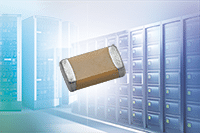source: Vishay news
MALVERN, Pa. — August 7, 2017 — Vishay Intertechnology, Inc. (NYSE: VSH) today introduced the industry’s first surface-mount multilayer ceramic chip capacitors (MLCCs) for high frequency RF and microwave applications to offer an operating temperature range to +200 °C. For telecom base stations and military communication systems, the Vishay Vitramon VJ HIFREQ HT series provides ultra high Q and low ESR in four compact case sizes.
For high power communication transmitters and high frequency inverters exposed to temperatures of +175 °C or higher, designers previously had to rely on MLCCs only qualified to +150 °C. With their operating temperature range from -55 °C to +200 °C, the devices released today provide reliable, long term performance in these applications. For increased design flexibility, the MLCCs’ small 0402, 0603, 0805, and 1111 case sizes allow for placement close to components with high dissipation, such as SiC and GaN switches.
VJ HIFREQ HT series devices are based on an ultra stable ceramic dielectric and offer a high serial resonant frequency (SRF) and parallel resonant frequency (PRF). The MLCCs feature broad working voltages from 16 V to 500 V and a wide capacitance range from 0.1 pF to 3.3 nF, with tolerance as tight as ± 0.05 pF. The devices offer an excellent aging rate of 0 % per decade and high ESD withstand capabilities to protect against high voltage transients.
Manufactured in noble metal electrode (NME) technology with a wet build process, the capacitors are available with a variety of RoHS-compliant termination finishes, including nickel barrier with 100 % matte tin plate for reflow assembly (code “X”), non-magnetic copper barrier for applications sensitive to magnetic interference (code “C”), and silver-palladium for conductive epoxy assembly (code “E”). The VJ HIFREQ HT series is also available with a lead-bearing (minimum 4 %) termination finish (code “L”). The devices are halogen-free and Vishay Green (excluding “L” termination).
Samples and production quantities of the VJ HIFREQ HT series are available now, with a lead time of nine weeks for larger orders.
Device Specification Table:
| Case | Max. voltage (V) | Capacitance | ||
|---|---|---|---|---|
| Minimum | Maximum | |||
| 0402 | 50 | 0.1 pF | 47 pF | |
| 0603 | 200 | 0.1 pF | 270 pF | |
| 0805 | 250 | 0.1 pF | 1.0 nF | |
| 1111 | 500 | 0.2 pF | 3.3 nF | |


































